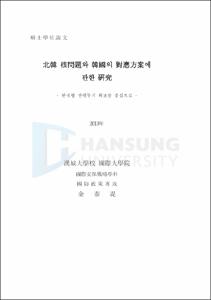北韓 核問題와 韓國의 對應方案에 관한 硏究
- Alternative Title
- 한국형 전략무기 확보를 중심으로
- Abstract
- Running contrary to the opposition casted from Korean and the international community, North Korea forcefully pushed forward with their second nuclear testing at 2009, following the previous 2006 testing. Despite the opposition from all dimensions, the motive to move forward with the testing was deemed as an act to sustain the dictatorial regime led by Kim Jong Il, and attempt to achieve rapid unification under North Korean terms through surprise offensives.
The challenge lies, however, on the fact that chances for success through collaborative dialogue are considered low at this time. As it was exhibited in the Six Party Dialogues from the past four years since the 2006 North Korean nuclear testing, the Dialogue itself proved ineffective due to the differences shown by each member, where even the resolutions extracted from long endeavors were interpreted differently by each participating countries.
Although South Korea must exert efforts to resolve the North Korean nuclear crisis through peaceful means with the international community, South Korea must also contemplate a responsive course of action to prepare against a North Korean nuclear provocation caused by misperception or misjudgment. Also, it is considered as a principle for the military to gear up full out readiness posture against such provocative threats. Therefore, a practical preparation to such scenario is the acquisition of a South Korean style strategic weapon system.
A South Korean style strategic weapon system is considered a weapon designed for massive destruction but basically deters or response to nuclear threats. Therefore, the possession itself is regarded as a strong political message to deter any aggressive intent displayed by its adversaries. Even in times of war, such system will dissuade the war fighting motive and capability of the adversary through the proper use of the system that calls in early victory or the cessation of war itself. However, the reason for acquiring such capabilities must be convincing and persuasive through cost benefit analysis.
The acquisition of a strategic weapon system must not only accompany a synergetic effect to the national wealth, but also guarantee strategic superiority over its enemy. The system must also bring regional stability in Northeast Asia by balancing with its neighboring countries such as China and Japan.
Although the South Korean style Strategic Weapon system is considered non-nuclear, in general it must comply with international norms and regulations. At first, it must consider the implications to the relationship with the U.S. and adjacent countries. In order to alleviate the concerns of another regional arms race, South Korea must show diplomatic efforts to ease such concern. Domestically, the government must convince the public on the need to acquire such system as well as to show efforts on other sector such as social welfare that the budget is being equally allocated to other primary areas for social need.
- Issued Date
- 2010
- Awarded Date
- 2010-02
- Type
- Thesis
- Files in This Item:
-
-
Download
 000000546783.pdf
기타 데이터 / 477.05 kB / Adobe PDF
000000546783.pdf
기타 데이터 / 477.05 kB / Adobe PDF
-
Items in Repository are protected by copyright, with all rights reserved, unless otherwise indicated.